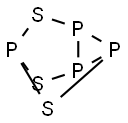Chemical Properties
Yellowish-green crystals; long rhombic needles; melts at 172°C (341°F); boils at 407–408°C (764–766°F);density 2.03 at 20°C (68 °F); soluble in carbon disulfide, benzene, and toluene, reacts with water.
Stable in the air. In the absence of O2 and
moisture, remains stable above 700°C. Decomposed by water at
elevated temperatures, evolving H3S. Soluble in CS3 and benzene.
These solutions become turbid in air almost immediately and
gradually deposit a copious, yellowish-white precipitate
Uses
Phosphorus sesquisulfide is used in in match tips.
Uses
Phosphorus sesquisulfide is used in making safety matches.
General Description
A yellow crystalline solid. Easily ignited by friction. Forms sulfur dioxide and phosphorus pentaoxide during combustion. Reacts with water to form phosphoric acid, a corrosive material. Used to make matches and in the manufacture of other chemicals.
Air & Water Reactions
Highly flammable.Slowly decomposed by water to form phosphoric acid and toxic hydrogen sulfide gas (H2S). May ignite on contact with water or moist air.
Reactivity Profile
PHOSPHORUS SESQUISULFIDE is a reducing agent.
Health Hazard
Highly toxic: contact with water produces toxic gas, may be fatal if inhaled. Inhalation or contact with vapors, substance or decomposition products may cause severe injury or death. May produce corrosive solutions on contact with water. Fire will produce irritating, corrosive and/or toxic gases. Runoff from fire control may cause pollution.
Health Hazard
Phosphorus sesquisulfide exhibited low to moderate acute oral toxicity in animals. An oral dose lethal to rabbits was reported to be 100 mg/kg (NIOSH 1986). Because of its low vapor pressure, any health hazard due to inhalation of this compound in the work place should be very low. There is no report on its acute inhalation toxicity. Its vapors may produce irritation of respiratory passage. Skin contact may cause mild irritation. It produces toxic sulfur dioxide on burning.
Fire Hazard
Produce flammable and toxic gases on contact with water. May ignite on contact with water or moist air. Some react vigorously or explosively on contact with water. May be ignited by heat, sparks or flames. May re-ignite after fire is extinguished. Some are transported in highly flammable liquids. Containers may explode when heated. Runoff may create fire or explosion hazard.
Flammability and Explosibility
Flammable
Safety Profile
Poison by ingestion.
Flammable by spontaneous ignition. When
heated to decomposition it emits very toxic
fumes of POx and SOx. See also SULFIDES
and PHOSPHORUS.
Synthesis
Phosphorus trisulfide can be synthesized either by Stock's method
(I), which involves fusing red P and S and carefully purifying the
crude product by recrystallization from CS3, followed by a second
recrystallization from benzene, or according to German patent
309,618 (F. C. Frary), which uses white P in a high-melting
inert solvent (II).
4 P + 3 S = P4S3
Purification Methods
Extract P4S3with CS2, filter it and evaporate it to dryness. Alternatively place it in H2O, and pass steam through it for an hour. The H2O is then removed, the solid is dried, and recrystallised from CS2 [Rogers & Gross J Am Chem Soc 74 5294 1952].
Waste Disposal
An alkaline solution is treated with laundry bleach, allowed to stand overnight, neutralized, and washed down the drain with plenty of water.



